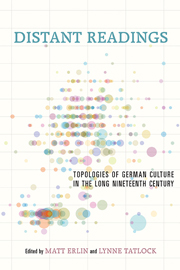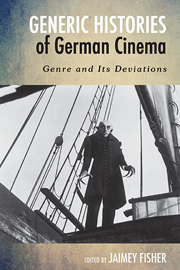38 results
14 - Carsten Nicolai's Art of Disturbance: Sound, Science, and Interference
-
-
- Book:
- A Companion to Sound in German-Speaking Cultures
- Published by:
- Boydell & Brewer
- Published online:
- 21 February 2024
- Print publication:
- 24 October 2023, pp 227-242
-
- Chapter
- Export citation
14 - Gesamtkunstwerk
- from Part III - Modernism In and Out of Kind: Genres, Composite Genres, and New Genres
-
-
- Book:
- The Cambridge History of Modernism
- Published online:
- 21 January 2017
- Print publication:
- 11 January 2017, pp 273-288
-
- Chapter
- Export citation
I - Quantification
-
- Book:
- Distant Readings
- Published by:
- Boydell & Brewer
- Published online:
- 05 April 2014
- Print publication:
- 01 May 2014, pp 27-28
-
- Chapter
- Export citation
Frontmatter
-
- Book:
- Distant Readings
- Published by:
- Boydell & Brewer
- Published online:
- 05 April 2014
- Print publication:
- 01 May 2014, pp i-iv
-
- Chapter
- Export citation
Selected Bibliography
-
- Book:
- Distant Readings
- Published by:
- Boydell & Brewer
- Published online:
- 05 April 2014
- Print publication:
- 01 May 2014, pp 347-370
-
- Chapter
- Export citation
III - Contextualization
-
- Book:
- Distant Readings
- Published by:
- Boydell & Brewer
- Published online:
- 05 April 2014
- Print publication:
- 01 May 2014, pp 257-258
-
- Chapter
- Export citation
1 - Burrows's Delta and Its Use in German Literary History
- from I - Quantification
-
- Book:
- Distant Readings
- Published by:
- Boydell & Brewer
- Published online:
- 05 April 2014
- Print publication:
- 01 May 2014, pp 29-54
-
- Chapter
- Export citation
Acknowledgments
-
- Book:
- Distant Readings
- Published by:
- Boydell & Brewer
- Published online:
- 05 April 2014
- Print publication:
- 01 May 2014, pp vii-viii
-
- Chapter
- Export citation
Contents
-
- Book:
- Distant Readings
- Published by:
- Boydell & Brewer
- Published online:
- 05 April 2014
- Print publication:
- 01 May 2014, pp v-vi
-
- Chapter
- Export citation
Contributors
-
- Book:
- Distant Readings
- Published by:
- Boydell & Brewer
- Published online:
- 05 April 2014
- Print publication:
- 01 May 2014, pp 371-374
-
- Chapter
- Export citation
II - Circulation
-
- Book:
- Distant Readings
- Published by:
- Boydell & Brewer
- Published online:
- 05 April 2014
- Print publication:
- 01 May 2014, pp 153-154
-
- Chapter
- Export citation
Index
-
- Book:
- Distant Readings
- Published by:
- Boydell & Brewer
- Published online:
- 05 April 2014
- Print publication:
- 01 May 2014, pp 375-386
-
- Chapter
- Export citation
13 - Can Computers Read?
- from III - Contextualization
-
-
- Book:
- Distant Readings
- Published by:
- Boydell & Brewer
- Published online:
- 05 April 2014
- Print publication:
- 01 May 2014, pp 333-346
-
- Chapter
- Export citation

Distant Readings
- Topologies of German Culture in the Long Nineteenth Century
-
- Published by:
- Boydell & Brewer
- Published online:
- 05 April 2014
- Print publication:
- 01 May 2014
2 - The Essay Film and Its German Variations
-
- Book:
- Generic Histories of German Cinema
- Published by:
- Boydell & Brewer
- Published online:
- 05 December 2013
- Print publication:
- 01 October 2013, pp 49-70
-
- Chapter
- Export citation
12 - Yearning for Genre: The Films of Dominik Graf
-
- Book:
- Generic Histories of German Cinema
- Published by:
- Boydell & Brewer
- Published online:
- 05 December 2013
- Print publication:
- 01 October 2013, pp 261-284
-
- Chapter
- Export citation
Bibliography
-
- Book:
- Generic Histories of German Cinema
- Published by:
- Boydell & Brewer
- Published online:
- 05 December 2013
- Print publication:
- 01 October 2013, pp 285-300
-
- Chapter
- Export citation
Index
-
- Book:
- Generic Histories of German Cinema
- Published by:
- Boydell & Brewer
- Published online:
- 05 December 2013
- Print publication:
- 01 October 2013, pp 305-326
-
- Chapter
- Export citation

Generic Histories of German Cinema
- Genre and its Deviations
-
- Published by:
- Boydell & Brewer
- Published online:
- 05 December 2013
- Print publication:
- 01 October 2013
Notes on the Contributors
-
- Book:
- Generic Histories of German Cinema
- Published by:
- Boydell & Brewer
- Published online:
- 05 December 2013
- Print publication:
- 01 October 2013, pp 301-304
-
- Chapter
- Export citation



